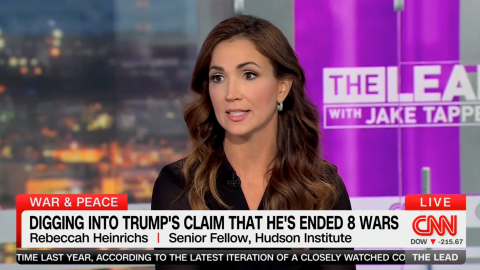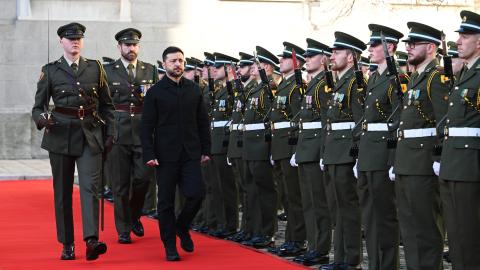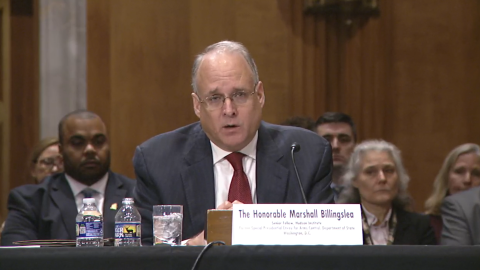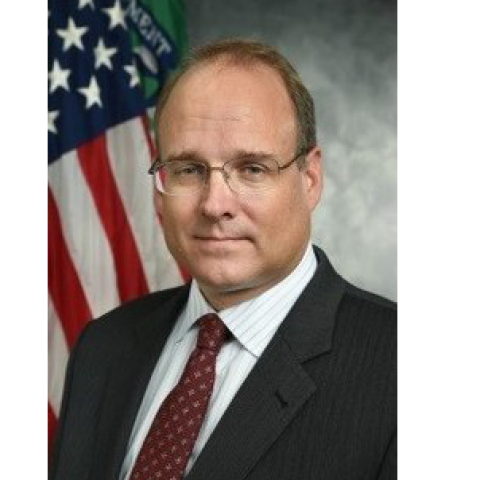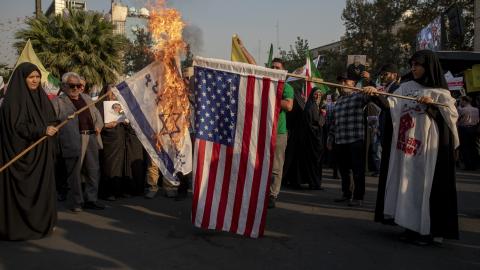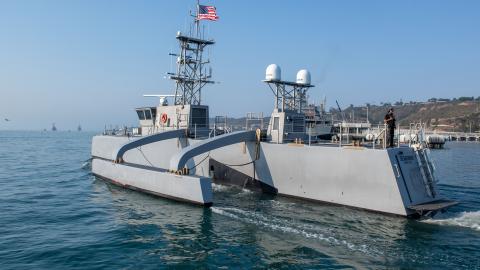On Thursday, November 6, the leaders of the five Central Asian republics known as the C5—Kazakhstan, Kyrgyzstan, Tajikistan, Turkmenistan, and Uzbekistan—will meet with President Donald Trump in Washington, DC, to mark the tenth anniversary of the C5+1 format. Established in 2015, the C5+1 is the main platform through which the United States engages collectively with the five countries of Central Asia.
For the past decade, Washington’s typical approach to C5+1 engagement was for the secretary of state to meet with his or her Central Asian counterparts on the sidelines of the United Nations General Assembly in New York. Some exceptions occurred in 2023, when President Joe Biden stepped in to host this sideline meeting, and in 2020 and 2021, when the C5+1 conducted its meetings virtually due to the pandemic. Marking the tenth anniversary with a head of state–level summit in Washington is an appropriate way to acknowledge both the growing importance of the region and the C5+1 format’s enduring relevance. At this year’s summit, observers expect that the Trump administration will focus on deepening economic relations, expanding trade, enhancing energy cooperation, developing rare earth mineral supply chains, and strengthening security ties.
This meeting comes at a pivotal geopolitical moment. Russian influence in Central Asia has waned because of its war in Ukraine. Meanwhile, the other major actor in the region, China, faces growing uncertainty over President Trump’s evolving trade policies. And on the region’s western flank, US relations with Türkiye are steadily improving. Ankara, thanks largely to the growing influence of the Organization of Turkic States (a bloc that also includes Azerbaijan, Kazakhstan, Kyrgyzstan, and Uzbekistan—with Turkmenistan as an observer), is becoming another important player in Central Asia.
The United States therefore has numerous opportunities to expand its regional influence. And President Trump will carry considerable diplomatic momentum going into the C5+1 gathering. He recently brought Armenian and Azerbaijani leaders together for a landmark summit that may achieve peace in the South Caucasus, a significant achievement in an area Moscow has long considered part of its traditional sphere of influence. While the United States is not a Eurasian country, it reestablished its importance to the region by hosting this August 8 meeting. With the right mix of diplomacy, economic engagement, and strategic vision, Washington could soon emerge as a genuine Eurasian power.
Why Central Asia Matters to the US
For the United States, engaging with Central Asia makes perfect sense. The region is rich in natural resources, including oil, natural gas, and rare earth minerals—which the Trump administration has prioritized. It is also home to some of the most important transit links on the Eurasian landmass—many of which have remained relevant since the days of the Silk Road.
The region also matters to America’s security interests, especially counterterrorism. Many fighters from the region traveled to Syria to support the so-called Islamic State, and other religious extremist terrorist organizations now operate freely in neighboring Afghanistan. But although the C5 countries are Muslim-majority, all have secular governments, and each has played an important role in curtailing the rise of extremism. They are well aware of this problem and have worked with the United States to prevent radicalization from becoming an even greater destabilizing force in the region.
Kazakhstan could be of particular interest to President Trump, who has repeatedly voiced concern about the increasing number of nuclear weapons globally. Kazakhstan’s commitment to nonproliferation has been one of its defining characteristics since it regained independence in 1991. Like Ukraine, it divested itself of all Soviet-remnant nuclear weapons. Furthermore, the country is home to the main Soviet nuclear test site, meaning that many Kazakhs have seen firsthand the terrible implications of these weapons. Kazakhstan can therefore be a valuable nonproliferation partner, especially as countries like Iran continue to pursue a nuclear capability.
A defining aspect of Central Asian states’ foreign policies is how they balance their international relationships, looking for alternative partners to offset Russia’s and China’s overwhelming influence. Since gaining independence from the Soviet Union, they have also proven they can be useful partners for Washington on counterterrorism, energy security, and regional stability.
After witnessing Russia’s stumbling campaign in Ukraine, leaders across Central Asia have expressed a desire to increase ties with the West. The United States should answer this call.
US Goals in the Region
With Russian influence waning, questions lingering about the future of US-China relations, and demand rising for new sources of rare earth minerals, the US should move quickly to expand mutually beneficial relations with the C5. Washington should have four main goals for Central Asia:
- Promote growth and stability. The US should support regional security and stability while encouraging economic growth. A secure and stable Central Asia offers many economic, trade, and energy opportunities—not only for the United States but also for US allies in Europe.
- Advance regional sovereignty. Ensuring that Central Asian countries can maintain their sovereignty and resist influence from outside powers (especially Russia and China) is in America’s interest.
- Increase Western engagement. The Central Asian republics’ balancing approach to foreign policy—when implemented responsibly and effectively—encourages regional stability, which benefits US interests. Therefore, US diplomats should not present engagement with Washington as mutually exclusive with ties to Moscow or Beijing. The US should pursue policies that enable regional governments to counterbalance their entanglements with these authoritarian powers by increasing engagement with the West.
- Establish energy and commerce routes that bypass Russia and Iran. Land-based trade and transit across Eurasia have driven economic development since the days of the Silk Road. This east–west artery remains important. With the US and its partners levying sanctions against Russia and Iran, many countries are seeking alternative trade and transit routes between Europe and Asia. There is only one viable option for east–west trade on the Eurasian landmass to bypass Russia and Iran: the Trans-Caspian International Transport Route. This artery, commonly known as the Middle Corridor, stretches from Central Asia, over the Caspian, and through the South Caucasus into Europe, from which goods enter global markets.
How the US Can Achieve Its Goals
Central Asia’s importance will only increase in the coming years. The region’s position at the crossroads of Eurasia and its abundant natural resources make it a key arena of great power competition. If America intends to advance its global interests, it cannot ignore the region. Therefore, the US should build on its momentum and continue to bolster its ties in Central Asia. Below are 11 steps to do so.
- Increase America’s political presence in the region. No sitting American president has visited any of the C5 republics, and even cabinet-level visits have been infrequent. Secretaries of State John Kerry, Mike Pompeo, and Antony Blinken each visited Central Asia just once. Donald Rumsfeld was the last secretary of defense to visit the region, in 2006. Meanwhile, Vladimir Putin and Xi Jinping—and their respective foreign ministers—regularly visit C5 capitals. Central Asia is long overdue for a high-level US visit.
- Publish a new Central Asia Strategy in the coming months. The White House should develop a Central Asia strategy that links the region more effectively to new South Caucasus transit routes. The US needs to define a new approach to account for the geopolitical changes that Central Asia has undergone since the last strategy was released five years ago. This new strategy should focus on connectivity and capitalize on recent transport and energy initiatives in the South Caucasus (the Southern Gas Corridor, the Ganja Gap, and the Trump Route for International Peace and Prosperity). It should also describe how policymakers can best link these initiatives to Central Asia.
Central Asian Nations Enclosed by Russia, China, Iran, and Afghanistan
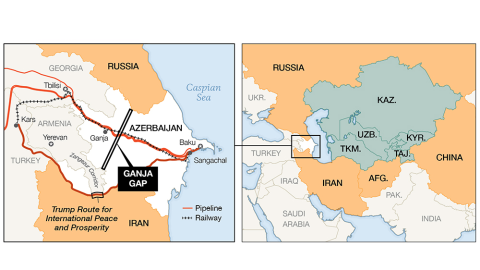
Source: Hudson Institute.
- Encourage regional countries to use the Middle Corridor. Container traffic along the Middle Corridor has grown rapidly in recent years. In 2022, container volumes increased by approximately 33 percent compared to 2021, reflecting growing demand for non-Russian transit routes. By 2024, traffic had more than doubled as governments and companies continued shifting logistics toward the Caspian-based corridor. Kazakhstan, a key energy exporter, has begun diversifying its strategic exports by making use of this route. About 64 percent of its westbound uranium exports now travel along the Middle Corridor, a sharp change from only a few years ago. The country also exported roughly 1.4 million tons of crude oil through the Baku–Tbilisi–Ceyhan pipeline in 2024 as part of a wider effort to lessen its dependence on Russian infrastructure. Astana plans to expand its export volume to about 2.2 million tons in the near future.
- Turn the C5+1 into the C5+2 by including Azerbaijan. For the US to engage successfully with Central Asia, it needs help from Baku. For economic, historical, and logistical reasons, Azerbaijan—while not a Central Asian country—is the gateway to the region for the transatlantic community. As the late American statesman Zbigniew Brzezinski once said, Azerbaijan is “the cork in the bottle containing the riches of the Caspian Sea Basin and Central Asia.” If the US wishes for these initiatives to succeed, Azerbaijan should have a seat at the table. This engagement can be as simple as adding a special session of the C5+2 at the end of the annual C5+1 meeting.
- Establish a US–Central Asia minerals partnership. Earlier this year the Trump administration signed a minerals agreement with Ukraine. This could serve as a model for new agreements with the countries of Central Asia, starting with Kazakhstan and Uzbekistan. Central Asia holds vast reserves of rare earth minerals and produces roughly half of the world’s uranium. But it lacks the necessary capital and technology to fully develop these resources. The US should help these governments explore, develop, and extract these minerals in a transparent and commercially viable way.
- Deepen economic and trade ties with Central Asia. So far in his second term, President Trump has made notable progress in this area. Earlier this year, the US concluded major commercial deals with Kazakhstan and Uzbekistan. Kazakhstan will spend $4 billion over the next decade on American-made locomotives for its rail network. Uzbekistan will spend billions on Boeing aircraft for its national airline. These large business agreements exemplify the kind of transactional diplomacy that President Trump favors and will help bind the region more closely to the United States. The administration should seek to facilitate more such agreements.
- Discuss Afghanistan—and Bagram Airfield in particular. The Central Asian states have pursued reluctant but pragmatic relations with the Taliban, engaging with them on a neighborly but de facto basis without formal diplomatic recognition. Tajikistan has been more hesitant because the most prominent armed anti-Taliban force, the National Resistance Front, is predominantly made up of ethnic Tajiks. Another notable element has been Trump’s public comments about reestablishing a US military presence at Bagram Airfield in Afghanistan. Located in the heart of Eurasia, it offers a vantage point over Central Asia, South Asia, Western China, and even parts of the Middle East. America’s abandonment of the base during its disastrous withdrawal from Afghanistan was a major folly. It remains to be seen whether President Trump will find a way to return American forces to Bagram. He should seek behind-the-scenes support from Central Asian leaders if he wishes to meaningfully pursue a return.
- Pursue bilateral engagements outside the C5+1 framework when necessary. While the C5+1 format should remain Washington’s primary nexus in the region, the administration should not hesitate to strengthen bilateral relationships with key Central Asian countries through other means. Until Secretary Pompeo’s visit to Kazakhstan and Uzbekistan in February 2020, secretaries of state typically visited all five Central Asian nations on a single trip—an approach that required significant time and coordination. Going forward, the US should be pragmatic and prioritize engagement with countries most aligned with American interests. This would put Kazakhstan and Uzbekistan at the head of the line as the C5 nations best positioned to engage with the US.
- Push for construction of a trans-Caspian natural gas pipeline between Turkmenistan and Azerbaijan. Just as the Clinton administration provided diplomatic and political support for the Baku–Tbilisi–Ceyhan oil pipeline in the 1990s, the Trump administration should use its newfound diplomatic momentum to work with Azerbaijan and Turkmenistan to promote the construction of a trans-Caspian gas pipeline that could connect Turkmenistan’s vast natural gas resources to European markets. In the short term, this could be quickly accomplished by an interconnector linking Turkmen and Azerbaijani gas fields in the Caspian, which are only 60 miles apart at their nearest points. An interconnector would serve as a confidence-building measure between the two sides and a proof of concept that could eventually lead to a fully developed gas pipeline under the Caspian.
- Explore military and security relations with willing Central Asian countries—but allow them to set the pace. The US has a history of basing troops in Central Asia and would benefit from reopening a military base in the region. But this is unlikely in the short term because the US has not done enough to maintain the necessary defense relationships. So the US should work to rebuild trust and confidence in the region, with a focus on restoring bilateral relationships. Then, someday, the circumstances might allow a new US base in the region.
- Fully leverage the US National Guard State Partnership Program. The State Partnership Program is an underutilized tool of US foreign policy. It pairs a state’s national guard with a partner country to strengthen security cooperation, disaster and emergency response, professional military education, and ties between the two nations. Currently, Kazakhstan is paired with the Arizona National Guard, Kyrgyzstan with Montana, Tajikistan with Virginia, Turkmenistan with Nevada, and Uzbekistan with Mississippi. The Pentagon should work with state authorities to ensure that the program facilitates robust engagement and productive joint training. By doing so, Washington can maximize the program’s potential as a low-burden, high-value mechanism for advancing US strategic interests in the region.
Conclusion
Central Asia is strategically located, resource-rich, and increasingly open to engagement with the West. With Russian influence waning, China’s ambitions expanding, and regional governments seeking new partners, the United States has a rare opportunity to reassert itself as a credible long-term partner. The upcoming C5+1 summit offers the perfect platform to do just that—setting US–Central Asian relations on a stronger, more strategic footing for the decade ahead.


